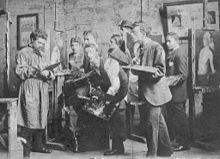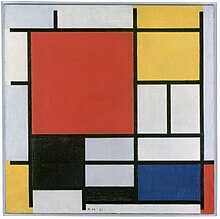Rijksakademie van beeldende kunsten
The Rijksakademie van beeldende kunsten (German: Reichsakademie der Bildenden Künste) is the Dutch art school founded in 1870 . It promotes visual artists through a two-year academy stay in Amsterdam .
In addition, in the past it was the site of the new Amsterdam Impressionist movement as part of the international Impressionist movement , also known in art history as the Allebé School . Essential impulses for the movement of modernity emanated from here. This was only made possible by the opening of teaching under the newly appointed director August Allebé in 1880. The most important pioneers include such well-known names as George Hendrik Breitner , Jan Toorop , Piet Mondriaan and Willem Arnoldus Witsen .
On the prehistory from 1718 to 1869
In the Kingdom of the Netherlands there was a municipal drawing school in Amsterdam from 1718 to 1819. It is also known under the name Amsterdamse Stads Teekenacademie . In 1820 the Royal Academy van Beeldende Kunsten was founded, which can then be seen as a continuation of this tradition. She mainly used the panel painting in the oil technique. The style in the curriculum was the historically grown landscape painting in connection with neoclassicism . From 1820 to 1830 this educational institution had to share the rank with the Koninklijke Academie van Beeldende Kunsten zu The Hague . In 1869 it was dissolved and realigned, from then on it bore the name Rijksakademie van beeldende kunsten .
History of the young Rijksakademie
The Rijksakademie van beeldende kunsten wants - according to its own understanding - to be a place where philosophers, scientists and artists come together to review and exchange knowledge and ideas. It was in 1870 by King Wilhelm III. founded in order to give visual artists training opportunities in the Netherlands through state funding for culture. Early students were u. a. George Hendrik Breitner , Isaac Israëls and Willem Witsen , from whom Amsterdam Impressionism would later originate. Under the patronage of the then director, Prof. August Allebé , the student movement “St. Lucas “(the patron saint of painters) to promote and deepen the artistic subjects at the academy and the collegial relationships among the students.
The academy today
In 1992 the state academy moved into a former cavalry barracks on Sarphatistraat, which was completely renovated and modernized for its current function.
In November 1999 it became an independent institution financed by a fund of the Ministry of Education and private sponsors. The institute also offers workshops with specialized professionals and a library with a focus on contemporary art and art history .
Invited artists are offered a grant and a studio . Every year around twenty international scholarship holders are invited. The number of applicants has been around 1200 in recent years. Less than half come from the Netherlands . Famous artists and important art critics are invited to regular visits to the resident's studios.
Prix de Rome
The award was initiated by the French Prix de Rome in 1666 and is - at 200 years old - the oldest and most highly endowed art promotion award.
Under the then King Louis-Napoléon Bonaparte , the Prix de Rome has been launched in the Kingdom of the Netherlands since 1808, similar to the French model. It was also intended for young up-and-coming artists and architects. The new King of the United Kingdom of the Netherlands , William I , confirmed the continuation of this art policy. This happened in connection with the creation of the two royal academies, the Koninklijke Akademie van Beeldende Kunsten in Amsterdam and the Koninklijke Academie van Beeldende Kunsten in The Hague. It would take until 1823 for this competition to start.
In 1851 the then Minister Thorbecke increased the prize money. In 1870 the implementation was transferred to the director of the Rijksacademie van beeldende kunsten in Amsterdam. There was a 1st and a 2nd prize, the gold and silver "eerepenning". Beginning in 1884, the winner was granted a grant of twelve hundred dollars. Four candidates were selected by means of a pre-selection, who had to write a paper within a given time frame. These were presented to the public via an exhibition, which went along with the decision of the jury.
In 1985 the Prix de Rome was redesigned. The prize money was increased and more artists were allowed to participate. New categories have also been added. From 2006 it was renamed "Prix de Rome.nl" and only awarded in two categories:
- Category 1: Fine arts and
- Category 2: architecture.
It is only awarded in cycles, each with a one-year break. There is only one winner and first place is endowed with € 40,000 combined with a subsequent stay abroad. Since 2013, the Rijksakademie has transferred the organization to the Mondriaan Fund . The Prix de Rome continues to be seen as an important competitor to international prizes.
Well-known lecturers and professors
- Hans Aarsman (1951)
- August Allebé (1838–1927), he was initially professor from 1870 and from 1880 to 1906 director at the academy.
- Jan Bronner (1881–1972), he was a professor of sculpture.
- Pierre Cuypers (1827-1921)
- Carel Ludewijk Dake (1857-1918)
- Antoon Derkinderen (1859-1925), he followed Allebé until 1927 as director of the academy.
- Marinus Heijl (1835-1931)
- Richard Roland Holst (1868–1938), he was initially a professor and from 1927 replaced Antoon Derkinderen as director of the academy.
- Johannes Hendricus Jarres , he was only a lecturer at the academy (1875–1946)
- Petrus Josephus Lutgers (1808-1874)
- Charles Verlat (1824-1890)
- Nicolaas van der Waay (1855–1936)
- Gerhard Westermann (1880–1971), he was only a lecturer at the academy.
- Petrus van Wijnveld (1820–1902), he was initially a professor and from 1862 director of the academy.
Known students
- Lizzy Ansingh (1875-1959)
- Karel Appel (1921-2006)
- Piet Arntzenius (1864–1925)
- Unica Bachmann-Calcoen (1904–1986)
- Nicolaas Bastert (1854–1939)
- Jo Bauer-Stumpff (1873–1964)
- Tjeerd Bottema (1884–1978)
- Johan Braakensick (1858–1940)
- George Hendrik Breitner (1857-1923)
- Jan Bronner (1881–1972)
- Cornelius de Bruin (1870-1940)
- Antoon Derkinderen (1859–1925)
- Leo Gestel (1881-1941)
- Arnold Marc Gorter (1866–1933)
- Richard Holst (1868–1938)
- Isaac Israëls (1865-1934)
- Cornelius Jetses (1873–1955)
- Klaas Koster (1885–1969)
- Hendrik Maarten Krabbé (1868–1931)
- Jacobus van Looy (1855-1930)
- Kees Maks (1876-1967)
- Bjarne Melgaard (1967)
- Samuel Jessurun de Mesquita (1868–1944)
- Wally Moes (1856-1918)
- Piet Mondriaan (1872–1944)
- Constant Anton Nieuwenhuys (1920-2005)
- Anthon van Rappard (1858-1892)
- Coba Ritsema (1876–1961)
- Suze Robertson (1855-1922)
- Bojan Šarčević (1974)
- Jan Sluyters (1881–1957)
- Hobbe Smith (1862-1942)
- Willem Bastiaan Tholen (1860-1931)
- Jan Toorop (1858-1928)
- Maurits van der Valk (1857-1935)
- Jan Pieter Veth (1864-1925)
- Nicolaas van der Waay (1855–1936)
- Gerhard Westermann (1880–1971)
- Petrus Theodorus van Wijngaerdt (1873–1964)
- Jan Hillebrand Wijsmuller (1855–1925)
- Ernst Witkamp (1854-1897)
- Willem Witsen (1860-1923)
Bibliographies
- Bionda, Richard and Blotkamp (1990): The Dutch Age of Painting - Van Gogh 1880-1895 , catalog, Uitgeverij Wanders bv, Zwolle, ISBN 90 6630 128 7 .
- Hammacher, AW (1946): Amsterdamsche Impressionisten en hun Kring , Amsterdam, JM Meulenhoff
- Loos, Wiepke and van Serooskerken, Carpel van Tuyll (1988): Waarde Heer Allebé - Leven en werk van August Allebé (1838-1927) , Wanders, ISBN 9-0663-0124-4
- Muller, Sheila D. (2013): Dutch Art - An Encyclopedia , Routledge, ISBN 1-1354-9574-2
- Bley, Britta (2004): From State to Nation: On the Role of Art in the Formation of a Dutch National Consciousness in the Long 19th Century. LIT Verlag, Berlin-Hamburg-Münster 2004, ISBN 978-3-8258-7902-0 .
- Bock, Manfred; Johannisse, Sigrid and Stissi, Vladimir (1997): Michel de Klerk: architect and artist of the Amsterdam School, 1884-1923 , Rotterdam: NAI Publishers, ISBN 90-5662-047-9 .
- Broude, Norma (1990): Impressionism - An International Movement 1860-192 0, DuMont Buchverlag in Cologne, ISBN 3-7701-2601-7
- Jenny Reynaerts (2008): The Wide View - Landscapes of the Hague School from the Rijksmuseum , exhibition catalog, Hatje Cantz, Ostfildern, ISBN 978-3-7757-2270-4 .
- Moes, Wally (1913): Gooische dorpsvertellingen , Scheltema & Holkema's Boekhandel (K. Groesbeek & Paul Nijhoff), Amsterdam.
- Renske Suyver (2011): A Reflection of Holland - the Best of the Hague School in the Rijksmuseum , Rijksmuseum Amsterdam, ISBN 9086890482 .
- John Sillevis, Hans Kraan, Roland Dorn (1987): The Hague School - Masterpieces of Dutch painting of the 19th century from Haags Gemeentemuseum , exhibition catalog, Ed. Braus, Heidelberg, ISBN 3-925835-08-3 .
- Ronald de Leeuw, John Sillevis, Charles Dumas (eds.) (1983): The Hague school - Dutch masters of the 19th century , exhibition catalog, Gemeentemuseum, Den Haag, Weidenfeld & Nicolson, London, ISBN 0-297 78069 7 .
- Anna Wagner (1972): The Hague School - Dutch painters a hundred years ago. Rheinisches Landesmuseum Bonn, ISBN 3 79270142 1 .
Web links
- Website of the Rijksakademie (Dutch / English)
- Dutch Prix de Rome also Prix de Rome.nl
- Mondriaan Fund or Mondriaan Fund
Individual evidence
- ^ The opposite pole and competitor was the Koninklijke Academie van Beeldende Kunsten zu The Hague. It was founded in 1682 and was initially an evening school for painting and drawing - on Saturday the club evenings took place, where sociability and professionalism were the focus. From 1820 to around 1830, Amsterdam and The Hague vied for supremacy in the art world of the Kingdom of the Netherlands. The merger with the engineering school gave The Hague a pioneering role, which is also reflected in the new building on Prinsengracht .
- ↑ Bonington with the British watercolor movement and the impending upheaval by William Turner , John Constable and Richard Parkes was not taken into account here.
- ↑ This circle of friends then organized an annual art exhibition in the later years, which contributed significantly to the cultural enrichment of the metropolis of Amsterdam.
- ↑ The Prix de Rome was first created by the French King Louis XVI. launched to enable young talented architects, painters and sculptors to study art in Rome. It was initially awarded by the Académie royale de peinture et de sculpture and after its dissolution from 1803 by the Académie des Beaux-Arts until 1968.
- ↑ After the student revolt of 1968, the sponsorship award has been canceled to this day.
- ↑ This returned to the original intention.
- ↑ This is the Koninklijke Academie van Beeldende Kunsten , the predecessor of the current Rijksakademie van beeldende kunsten .
- ↑ a b c d She was a member of the Amsterdamse Joffers movement .
- ↑ Jan Bronner was appointed professor for sculpture at the academy early on.
- ↑ He later became a professor and then followed Prof. August Allebé as director at the Rijksakademie in Amsterdam.
- ↑ He later became a professor and followed Antoon Derkinderen as director at the Rijksakademie in Amsterdam.
- ↑ In 1904 Jan Slyters had received the Prix de Rome.








